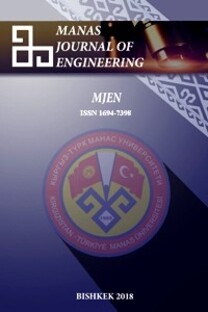Determination of the temperature distribution in a rectangular cooling fin using the finite element method
___
- [1]. A.D. Kraus, A. Aziz, J.R.. Welty Extended Surface Heat Transfer John Wiley, New York, 2002.
- [2]. A. Aziz, M.N. Bouaziz, “A least squares method for a longitudinal fin with temperature dependent internal heat generation and thermal conductivity”, Energy Convers Manag, 52, pp. 2876-2882, 2011.
- [3]. A. Razani, G. Ahmadi, “On optimization of circular fins with heat generation”. J Frankl Inst, 303 (2), pp. 211-218, 1977.
- [4]. H.C. Unal, “Temperature distributions in fins with uniform and non-uniform heat generation and non-uniform heat transfer coefficient”. International Journal of Heat and Mass Transfer, 30 (7), pp. 1465-1477, 1987.
- [5]. Shouman AR. “Nonlinear heat transfer and temperature distribution through fins and electric elements of arbitrary geometry with temperature dependent properties and heat generation”. NASA technical note, TN D-4257, 1968.
- [6] B. Kundu, “Performance and optimum design analysis of longitudinal and pin fins with simultaneous heat and mass transfer: unified and comparative investigations” Appl Therm Eng, 27, pp. 976-987, 2007.
- [7]. G. Domairry, M. Fazeli, “Homotopy analysis method to determine the fin efficiency of convective straight fins with temperature-dependent thermal conductivity” Commun Nonlinear Sci Numer Simul, 14, pp. 489-499, 2009.
- [8]. D.D. Ganji, Z.Z. Ganji, H.D. Ganji, “Determination of temperature distribution for annual fins with temperature-dependent thermal conductivity by HPM” Therm Sci, 15, pp. 111-115.
- [9]. A. Aziz, F. Khani, “Convection–radiation from a continuously moving fin of a variable thermal conductivity” J Frankl Inst, 348, pp. 640-651, 2011.
- [10]. M.N. Bouaziz, A. Aziz, “Simple and accurate solution for convective–radiative fin with temperature dependent thermal conductivity using double optimal linearization” Energy Convers Manag, 51, pp. 2776-2782, 2010.
- [11]. Mustafa Inc, “Application of homotopy analysis method for fin efficiency of convective straight fins with temperature-dependent thermal conductivity” Math Comput Simul, 79, pp. 189-200, 2008.
- [12]. J.K. Zhou. Differential Transformation Method and its Application for Electrical Circuits Hauzhang University press, Wuhan, China, 1986.
- [13]. S. Ghafoori, M. Motevalli, M.G. Nejad, F. Shakeri, D.D. Ganji, M. Jalaal, “Efficiency of differential transformation method for nonlinear oscillation: comparison with HPM and VIM” Curr Appl Phys, 11, pp. 965-971, 2011.
- [14]. I.H. Abdel-Halim Hassan, “Application to differential transformation method for solving systems of differential equations” Appl Math Model, 32, pp. 2552-2559, 2008.[15]. M. Hatami, D.D. Ganji, “Thermal behavior of longitudinal convective–radiative porous fins with different section shapes and ceramic materials (SiC and Si3N4)” Ceram Int, 40, pp. 6765-6775, 2014.
- [16]. M. Hatami, D.D. Ganji, “Thermal and flow analysis of microchannel heat sink (MCHS) cooled by Cu–water nanofluid using porous media approach and least square method”. Energy Convers Manag, 78, pp. 347-358, 2014.
- [17]. M. Hatami, D.D. Ganji “Investigation of refrigeration efficiency for fully wet circular porous fins with variable sections by combined heat and mass transfer analysis” International Journal of Refrigeration, 40, pp. 140-151, 2014.
- [18]. M. Hatami, D.D. Ganji, “Thermal performance of circular convective-radiative porous fins with different section shapes and materials” Energy Convers Manag, 76, pp. 185-193, 2013.
- [19]. M. Hatami, A. Hasanpour, D.D. Ganji “Heat transfer study through porous fins (Si3N4 and Al) with temperature-dependent heat generation” Energy Convers Manag, 74, pp. 9-16, 2013.
- ISSN: 1694-7398
- Yayın Aralığı: 2
- Başlangıç: 2001
- Yayıncı: KIRGIZİSTAN-TÜRKİYE MANAS ÜNİVERSİTESİ
Tarih Eren BABÜR, Kemal Kaan TEKİNŞEN, Ümit GÜRBÜZ
Investigation of Fatty Acid Composition, Thermal and Rheological Behavior of Yak, Cow and Horse Fats
Jamila SMANALİEVA, Zhyldyzai OZBEKOVA, Asylbek KULMYRZAEV, Peter FİSCHER
Vuslat SARIKAYA, Osman TUTKUN, Kurmancan KAPAROVA
Solutions of the system of maximum difference equations
Hava Çavuşoğlu VATANSEVER, Ayşegül Ersoy MERİÇBOYU
Gizem Eker SANLI, Busra TANDOGAN
